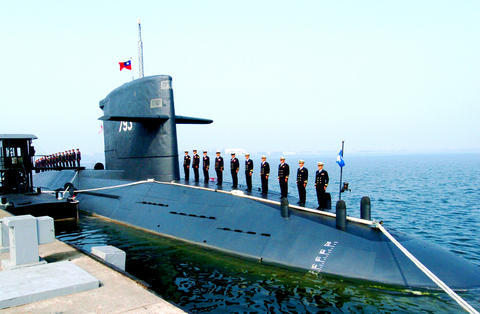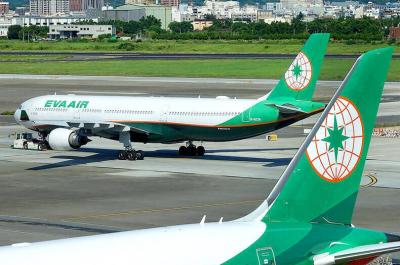New ships don't come easily for the nation's Navy. While commanding officers were celebrating the 20 years of service for the nation's two Dutch-made Zwaardvis-class diesel-electric submarines earlier this month, they must have been hoping for speedy legislative approval of a budget proposal for eight new US diesel-electric submarines.
The budget remains blocked in the legislature by the Chinese Nationalist Party (KMT). KMT Legislator Su Chi (
While attending the celebrations on Dec. 18 marking the 20th anniversary of the SS-793 Sea Dragon and SS-794 Sea Tiger at Mercury Port at the nation's largest naval base in Tsoying, Kaohsiung, President Chen Shui-bian (

PHOTO: CHANG CHUNG-YI, TAIPEI TIMES
Mercury Port houses the Navy's full complement of four submarines, which include two US-made Guppy-class (World War II era) vessels -- the SS-791 Sea Lion and SS-792 Sea Leopard -- as well as the two Dutch-made vessels.
The Navy's submarine fleet commander Rear Admiral Huang Shu-kuang (
"I would venture that we still have quality submariners despite the age of our vessels. I am also confident that our remaining submarines are all in very good shape and capable of accomplishing all our necessary missions," Huang said.
Just last month, the Sea Tiger and its crew completed a challenging long-term mission. But because of the sensitive nature of the exercise, the Navy could not provide any details.
Naval Commander-in-Chief Admiral Wang Li-shen (
TOUGH JOB
Retired Rear Admiral Ding Chien-ching (
The first group of sailors that was assigned to the two Dutch-made submarines had it even tougher as they participated in the entire building process of the two vessels.
"I am quite proud to say that we know every single nut and bolt on those vessels," Ding said.
The retired captain said he and his fellow sailors arrived in Holland in 1983, when construction was just beginning on the two submarines. Every one of them participated in the process and they also did the final tests on their own when the two vessels were completed.
"Our only hope was to finish the job as soon as possible so the two submarines could begin service as soon as possible," Ding said.
In the Navy, submariners are regarded as hard-working and low-profile navy boys, he said.
"That is because most of the time on board a submarine, we have to get a lot of things done instead of wasting our time complaining," Ding said. "That is what we were trained for and also the spirit of submarine personnel -- just shut up and do it."
Ding's remarks were echoed by Captain Chan Ying-chi (
"People ask me what it takes to become a submarine captain. I tell them the spirit of `follow me' is the key in leading the crew," Chan said.
As a leader, Chang said he always tries to encourage his fellow seamen by doing it first and doing it himself.
"Gradually, you become a role model and the rest of the sailors will follow you," Chan said. "Do not complain. Just do it."
The Zwaardvis Class (Swordfish) is a conventional attack submarine that replaced the Dolfijn Class in the Royal Netherlands Navy. It is based on the US Barbel Class with a teardrop hull design. Taiwan ordered two modified Zwaardvis Class submarines in September of 1981.
A repeat order for four additional vessels was turned down by the Netherlands in 1992 following pressure from China.
The Zwaardvis, which is 66.9m long, weighs 2,376 tonnes on the surface and 2,660 tonnes when submerged. It has six torpedo tubes. Top speed is about 20 knots (37kph). It carries 67 sailors, including eight officers and can dive to 240m.

The first global hotel Keys Selection by the Michelin Guide includes four hotels in Taiwan, Michelin announced yesterday. All four received the “Michelin One Key,” indicating guests are to experience a “very special stay” at any of the locations as the establishments are “a true gem with personality. Service always goes the extra mile, and the hotel provides much more than others in its price range.” Of the four hotels, three are located in Taipei and one in Taichung. In Taipei, the One Key accolades were awarded to the Capella Taipei, Kimpton Da An Taipei and Mandarin Oriental Taipei. Capella Taipei was described by

The Taichung District Court yesterday confirmed its final ruling that the marriage between teenage heir Lai (賴) and a man surnamed Hsia (夏) was legally invalid, preventing Hsia from inheriting Lai’s NT$500 million (US$16.37 million) estate. The court confirmed that Hsia chose not to appeal the civil judgement after the court handed down its ruling in June, making the decision final. In the June ruling, the court said that Lai, 18, and Hsia, 26, showed “no mutual admiration before the marriage” and that their interactions were “distant and unfamiliar.” The judge concluded that the couple lacked the “true intention of

EVA Airways today confirmed the death of a flight attendant on Saturday upon their return to Taiwan and said an internal investigation has been launched, as criticism mounted over a social media post accusing the airline of failing to offer sufficient employee protections. According to the post, the flight attendant complained of feeling sick on board a flight, but was unable to take sick leave or access medical care. The crew member allegedly did not receive assistance from the chief purser, who failed to heed their requests for medical attention or call an ambulance once the flight landed, the post said. As sick

INDUSTRY: Beijing’s latest export measures go beyond targeting the US and would likely affect any country that uses Chinese rare earths or related tech, an academic said Taiwanese industries could face significant disruption from China’s newly tightened export controls on rare earth elements, as much of Taiwan’s supply indirectly depends on Chinese materials processed in Japan, a local expert said yesterday. Kristy Hsu (徐遵慈), director of the Taiwan ASEAN Studies Center at the Chung-Hua Institution for Economic Research, said that China’s latest export measures go far beyond targeting the US and would likely affect any country that uses Chinese rare earths or related technologies. With Japan and Southeast Asian countries among those expected to be hit, Taiwan could feel the impact through its reliance on Japanese-made semi-finished products and